|
On March 21, the U.S. House of Representatives, Committee on Agriculture, Subcommittee on Nutrition, held a public hearing, "The Next Farm Bill: Nutrition Distribution Programs," focusing on the Commodity Supplemental Food Program (CSFP), the Food Distribution Program on Indian Reservations (FDPIR), and The Emergency Food Assistance Program (TEFAP). Describing the value of these programs were four witnesses, pictured left to right below:
-
Carrie Calvert, Director of Tax and Commodity Policy, Feeding America, Washington, D.C.
-
Frank Kubik, CSFP Director, Focus: HOPE, Detroit, Michigan
-
Jerry Tonubbee, Director - Food Distribution Program, Choctaw Nation of Oklahoma, Durant, Oklahoma
-
Diane Kriviski, Deputy Administrator for Supplemental Nutrition and Safety Programs, USDA Food and Nutrition Service, Alexandria, Virginia
View the recording of the hearing or click here to visit the hearing webpage where you can download the written testimony of each witness.
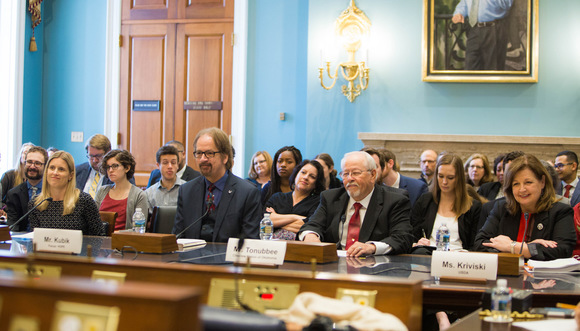
 USDA is launching a survey to gather feedback from the readers of this monthly "USDA Foods from Farm to Plate" e-letter. Share your thoughts on what you enjoy and what you think we could improve! As we work to develop content our readers are interested in, we would greatly appreciate your feedback by May 5. Click here to take this quick 8-question survey!
|

From December 1, 2016, through February 15, 2017, the USDA Food and Nutrition Service hosted our 2nd annual USDA Foods “Show Us Your Tray” photo contest. The goal of the contest was to highlight the wonderful ways schools are incorporating USDA Foods into their menus. We received more than 500 submissions, topping the total of 200 submissions for the 2016 contest!
Prince William County Public Schools in Virginia took the top prize with their Baja Cantina Nachos! These Baja Cantina Nachos used USDA direct delivery fajita chicken, topped with cheese sauce from the USDA Foods processing program and pico de gallo made with USDA DoD Fresh tomatoes and red onions. The tray also featured corn salad using USDA DoD Fresh tomatoes, red onion, and peppers; USDA direct delivery canned pears topped with USDA DoD Fresh blueberries; and USDA DoD Fresh apple slices. This vibrant, fresh, delicious, and colorful photo caught the judges' attention, and the meal is surely a crowd favorite with the students in Prince William County. Thank you to everyone who took the time to participate in the “Show Us Your Tray” photo contest, and congratulations to the winner!
The Business Management Improvement (BMI)
project was initiated in October
2015 to improve USDA Foods procurement and delivery processes. This is a
significant milestone in the evolution of the USDA Foods program providing
stakeholders with an opportunity to provide their input to process improvements.
Throughout
2016, a team of stakeholders representing USDA, Indian Tribal Organizations, State Distributing Agencies, and Industry collaborated in a series of workshops and
interviews to review the current “As-Is” state and evaluate possible solutions
for the future “To-Be” state. During these phases, the project team identified
several process challenges and pain points that impact suppliers, recipients,
processors, and USDA staff. The team then examined relationships between supply
chain activities and proposed opportunities for change. A business case and implementation plan are being developed. Further updates will be provided pending approval,
prioritization, and identification of scheduling and computer system changes.
For related news and additional information, visit the BMI webpage. Any questions or
comments about the BMI may be directed to CP-BPRINFO@ams.usda.gov.
Although the school year has not yet started, USDA is well underway with planning and collecting requests from States and school districts indicating which foods they would like to receive in the upcoming school year. In January, USDA sent out the updated list of products that will be available in School Year 2017-2018, with a few exciting additions to the list and product improvements that resulted from feedback from our stakeholders.
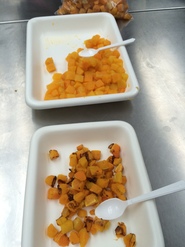
New Items:
-
Eggs, Liquid Whole, Frozen, 12/2 lb cartons- Option provided in addition to 6/5 lb cartons. Provides smaller unit size to accommodate batch cooking.
-
Potatoes, Diced, Frozen, 6/5 lb bags- Product is frozen, diced potatoes with no flavoring or coating. Dice size is ½ inch cubes.
-
Blueberries, Wild, Unsweetened, Frozen, 8/3 lb bags- Offered in addition to 30 lb packages. Provides smaller unit size to accommodate batch cooking.
-
Pollock Fish Sticks, Frozen, 8/5 lb or 4/10 lb bags- Product uses deep skin Pollock block that is cut in a way that removes the dark fat line to give the fish a white, flaky interior. It is made with a whole grain-rich breading.
-
Butternut Squash, Diced, Frozen, 6/5 lb bags-
Product is IQF and cut into ¾ inch dice pieces. Pictured above before and after roasting.
-
Strawberries, IQF Sliced, 6/5 lb- Product is IQF
sliced and does not contain added sweetener.
-
Yogurt, High-Protein, Peach, 24/4 oz cups-
Product is high protein, or Greek-style. Will be offered in addition to
vanilla, strawberry, and blueberry flavor options.
Reformulated Items:
-
Cheese, Mozzarella, Low Moisture Part Skim AND
Lite, Shredded, Frozen- Specification updated to ensure a more consistent
product with regard to melting and appearance.
-
Tuna, Canned- All products required to contain
an approved commercial kosher certification, as defined by the specification.
-
Sunflower Seed Butter- All products required to
contain an approved commercial kosher certification, as defined by the
specification. Product must be made in a peanut and tree nut free
facility.
-
Peanut Butter, Individual Portion- Specification
updated to increase ease of opening the package.
-
Ham, Whole/Sliced/Diced- Specification updated
to decrease sodium to ≤650 mg/100 g serving.
-
Yogurt, All Flavors- Specification updated to
add an upper limit for sugar that is consistent with the Child and Adult Care Food Program (CACFP) meal pattern.
For a complete list of USDA Foods items available to Child
Nutrition Programs in School Year 2017-2018, click here.
To view the product specifications, click here.
|
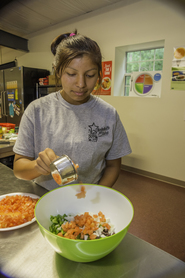
The Fiscal Year 2017 Request for Applications (RFA) for the Food Distribution Program Nutrition Education (FDPNE) Grant is open March 1-May 1. Since 2008, FDPNE has made approximately $1 million available per year for Food Distribution Program on Indian Reservations (FDPIR) operators to apply competitively for nutrition education grants.
Examples of activities conducted by grantees in the past include nutrition education classes, cooking demonstrations, taste testing of items available through FDPIR, gardening projects, and more. Click here to view or download the FDPNE RFA from Grants.gov!
|
The Defense Logistics Agency (DLA), a component of the Department of Defense (DoD) and our partners in the USDA DoD Fresh Fruit and Vegetable Program, recently published an article, "Collards to Kale," tracing the history of this unique collaboration and showcasing the experience of the North Carolina Department of Agriculture and Consumer Services.
 Click here to read the article and view the set of five photos!
Photo: (From left) Ken Wilmoth and Pam Hamlett from DLA Troop Support stand in front of the North Carolina Department of Agriculture’s Farm to School truck with NCDA’s warehouse administrator, Ted Fogleman, and Bob Sitton, NCDA assistant director. Photo By: Beth Reece
|
Rosie Krueger of the Vermont Agency of Education created an insightful fact sheet, "USDA Foods: Supporting Vermont Agriculture," that highlights purchases from Vermont and regional producers - from apples and blueberries to Greek-style yogurt and zucchini - for Vermont school meals through the USDA Foods and USDA DoD Fresh programs.
 Vermont has been working to increase the local and regional food offerings available from USDA and also notes another way the USDA Foods program can support local purchasing. Here's an excerpt from the fact sheet:
"Menuing USDA Foods = More $ for Local Foods: USDA Foods are purchased by the federal government in bulk and offered to schools at a lower cost than commercially available foods. Smart menu planning to fully utilize USDA Foods allows Vermont School Meals programs a little extra room in their budget to purchase things like local beef, eggs and produce."
Thanks, Vermont, for demonstrating that "all USDA Foods are local to someone!" Check out the new fact sheet on Vermont's Farm to School website and the USDA Foods State of Origin report and think about how your state can spotlight the benefits of USDA Foods for your school lunches and local farmers!
|
USDA Foods webinar recordings are posted on the USDA Food and Nutrition Service YouTube channel in the Food Distribution playlist, and you can also view the list of webinars and other available training resources on the Food Distribution Webinars and Training page. View these recently posted videos:
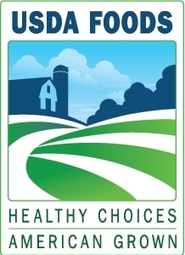 USDA Foods have evolved over the years, as we have increased the quantity and variety of offerings and improved the nutrition profile of our foods. To reflect these positive changes, in 2010 we introduced the term "USDA Foods" to replace the term "commodities" in referring to these 100% domestically grown and produced foods offered through our school and household food distribution programs. Old habits die hard, and we know many of our program stakeholders still affectionately refer to our foods as "commodities," but we want to remind you how far the program has come and that this is no longer your grandmother's government cheese! USDA Foods = the fajita chicken in your Baja Cantina Nachos (see "Show Us Your Tray" photo contest article above). USDA Foods = the wild salmon at your FDPIR cooking demo (see "Out & About" article below).
USDA Foods today continue to support the dual mission inherent in the program's founding: supporting American agriculture and providing a nutrition safety net for school children, seniors, Native American communities, and individuals and families participating in emergency feeding and disaster feeding programs. USDA Foods are low in fat, sodium, and sugar, and our food packages consistently rate well above the average American diet in the Healthy Eating Index. In one of our webinars last year, a polling question asked about perceptions of USDA Foods, and a majority responded that they found USDA Foods to be equal to or better than what could be purchased on the commercial market. We are constantly striving to improve USDA Foods and meet the needs of our program participants and stakeholders, and we always appreciate your feedback!
|
 USDA staff recently had the opportunity to visit Lummi Nation FDPIR in Washington. Nutritionists led a cooking demo for clients featuring a new traditional food available through FDPIR, wild salmon, along with a tasty side dish. Participants enjoyed sampling Alaskan Sockeye Salmon with Orange Sauce and Whole Wheat Pasta with Broccoli, which they can recreate at home using the USDA Foods from their monthly food package as the main ingredients! Following the demo and taste test was a physical activity session. Since the day was too cold and windy for an outdoor activity, participants learned a series of exercises they can do indoors to exercise various muscle groups. Also, a nutritionist from Washington State University Extension set up a display, complete with samples and recipes, and explained the benefits of flavoring water with lemon, lime, and orange slices, rather than consuming sugary beverages. FDPIR clients enjoyed the interactive events, and USDA staff appreciate Lummi's hospitality in allowing us to visit and experience their excellent nutrition education program.
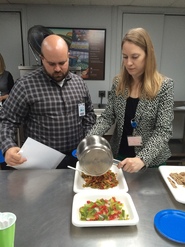
The USDA Foods Available List is a lot like any other menu, with dozens of healthy options for state agencies to order and distribute through USDA’s nutrition assistance programs. And every year, foods are added or removed from the list based on customer demand and market conditions. Some offerings are modified to improve nutrition content or make the product and its packaging easier to work with in the kitchen or more acceptable to kids.
The USDA Foods program is a collaboration between the Agricultural Marketing Service (AMS), the agency that procures the food, and the Food and Nutrition Service (FNS), the agency that distributes the food. This school year, the USDA Foods team’s goal for training and conferences is to provide more opportunities to taste new and reformulated products. That way, state agencies can confidently order them and school districts can incorporate them into their menus. Read more
|
 The Minnesota Department of Human Services has honored The Food Group, one of seven regional food banks distributing TEFAP in Minnesota, with the sixth annual Commissioner's Circle of Excellence Award alongside six other human service organizations that are making outstanding contributions to improve the lives of Minnesotans. Founded in 1976, The Food Group partners with more than 240 food shelves and hunger relief partners primarily in the Twin Cities metro area but extending across 21 counties. Click here to watch a three-minute video highlighting the innovative work of The Food Group and to learn more about its emphasis on nutrition as well as providing culturally specific foods for immigrant communities. Congratulations to The Food Group on this award!
|
Several USDA web applications, including WBSCM and FFAVORS, use eAuthentication
(eAuth) to manage login credentials. Users can recover a forgotten password using a series of security
questions established by the user. To address concerns about digital
security and privacy for its employees and customers, USDA has developed new security
questions that no longer use personally identifiable information (PII).
The new security questions went into effect earlier this year. If users
haven’t already done so, they will be prompted to select from the new non-PII
security questions and update their responses after the next successful eAuth
logon.
All users are encouraged to pay attention to the responses
provided for the security questions. If an external user forgets both the
password AND the security question responses, they will need to set up a new
eAuth account and reestablish access to FFAVORS and/or WBSCM with the new login
ID. To update the eAuth link for FFAVORS, contact the FFAVORS Help
Desk. For WBSCM, contact the user administrator for your organization.
If you have questions about these changes, please contact the eAuth Help
Desk.

Release Schedule and Updated Help Resources for
FFAVORS and WBSCM
Both the Fresh
Fruits and Vegetables Order/Receipt System (FFAVORS) and the Web-Based Supply Chain
Management System (WBSCM) follow regular release schedules to apply
upgrades, fixes, and new or enhanced features. Along with these system changes, related help resources are also updated. For this reason, users are encouraged to periodically
review the available help resources and replace any printed materials or locally saved files with the most up-to-date version.
FFAVORS: Releases
occur quarterly, with the most recent implemented on March 26, 2017.
When logged
in to FFAVORS, users will see an announcement describing any changes
applicable to their system role. The most current manual is available for
download via the Help link in the
upper right corner. The date of the last update is labeled on the front page of
the manual. Questions about the manual
may be directed to the DLA Account Specialist, if known, or to ffavors@fns.usda.gov.
WBSCM: Releases
occur monthly, with the most recent implemented on March 30, 2017.
When logged in
to WBSCM, navigate to the Help
tab -> Training tab. The Release Notes provide a summary of system
changes, related training materials, and the user group(s) impacted. Releases
are also announced on the forum, which users can follow
to receive email notifications. Work
Instructions and Job Aids show the date of the last update in the footer on the
PDF/Word version of the document. Questions about release notes and other
training materials may be directed to wbscm.servicedesk@caci.com or
(877) 927-2648.
USDA staff will be participating in these upcoming meetings in 2017. We look forward to the opportunity to meet you and hope to see you there!
April 23-26: American Commodity Distribution Association (ACDA) Annual National Conference in Denver, Colorado. View the full schedule and session descriptions here. USDA Food Distribution sessions include:
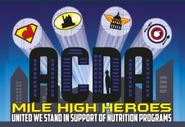
- "USDA Foods 101 for Industry" pre-conference session on Sunday, April 23
- A special track of breakout sessions April 24-26 to share the progress of USDA's Business Management Improvement Process and receive feedback from each of our stakeholder groups
- USDA General Session on Tuesday, April 25, 8:30-10:00 a.m. featuring USDA leaders
- Additional breakout sessions: The Amazing Race of a USDA Foods Product, The Latest Dish on USDA Foods Nutrition Topics, Household Highlights and the Bonus Purchase Process, Fresh Off the Press: Headlines from the USDA DoD Fresh Program, and Weighing In: Tips on Inventory Management for States
|
June 12-16: National Association of Food Distribution Programs on Indian Reservations (NAFDPIR) Annual Conference in St. Louis, Missouri
July 9-12: School Nutrition Association (SNA) Annual National Conference in Atlanta, Georgia
 Here's how to sign up for these updates via GovDelivery:
1. Go to the Food Distribution website.
2. Click on the red envelope on the row of social media icons on the top right of the page.
3. Enter your email address and click "Submit."
4. Check the boxes to select your topics of interest. For these e-letters, scroll down to the Food Distribution category and click the plus sign to the left of the check box to expand the list and view all the sub-categories. Check these sub-categories to receive the corresponding e-letters:
*USDA Foods --> receive all "USDA Foods from Farm to Plate" general + program-specific e-letters
*Commodity Supplemental Food Program (CSFP) --> receive "Household Highlights" e-letter
*The Emergency Food Assistance Program (TEFAP) --> receive "Household Highlights" e-letter
*Food Distribution Program on Indian Reservations (FDPIR) --> receive "FDPIR Connection" e-letter
*Schools/Child Nutrition Commodity Programs --> receive "Spotlight on Schools" e-letter
5. Update your subscription preferences any time by following the above steps or clicking on the Subscriber Preferences Page link at the bottom of any of the e-letter email messages you receive from GovDelivery. Questions? Contact us at USDAFoods@fns.usda.gov
|
|